
Centaurs: a warning from the future
An interview with Danish artist Uffe Isolotto
Back in 1937, the world’s population was just 2.3 billion, and the remaining wilderness of the planet was at 66%. By 2020, the population had reached almost 8 billion, and only 35% of nature had been left untouched.
What is the ecological awareness of these 8 billion people? How much further can the so-called growth of human civilisation expand? Is there a limit? To what extent are we capable of adapting to our own developmental advancement? What are the adaptation challenges that lie in wait?
This thought-provoking exploration of humanity’s interactions with technology, ecology and the future is offered by the hyper-realistic fantasy of Danish artist Uffe Isolotto and curator Jacob Lillemose in the form of the installation We Walked the Earth, which was first shown in the Danish Pavilion at the 2022 Venice Biennale. This summer, in deference to the artist’s home audience, the piece was shown at the Den Frie Centre of Contemporary Art in Copenhagen. Currently, the installation, specifically revised for Riga and titled We Walked the Earth: The Growth, is on show at the Latvian Museum of Contemporary Art’s new exhibition space New Hanza Biroji until November 19.
Installation view. We Walked the Earth Harnessing by Uffe Isolotto at the Den Frie Centre of Contemporary Art in Copenhagen. Photo: David Stjernholm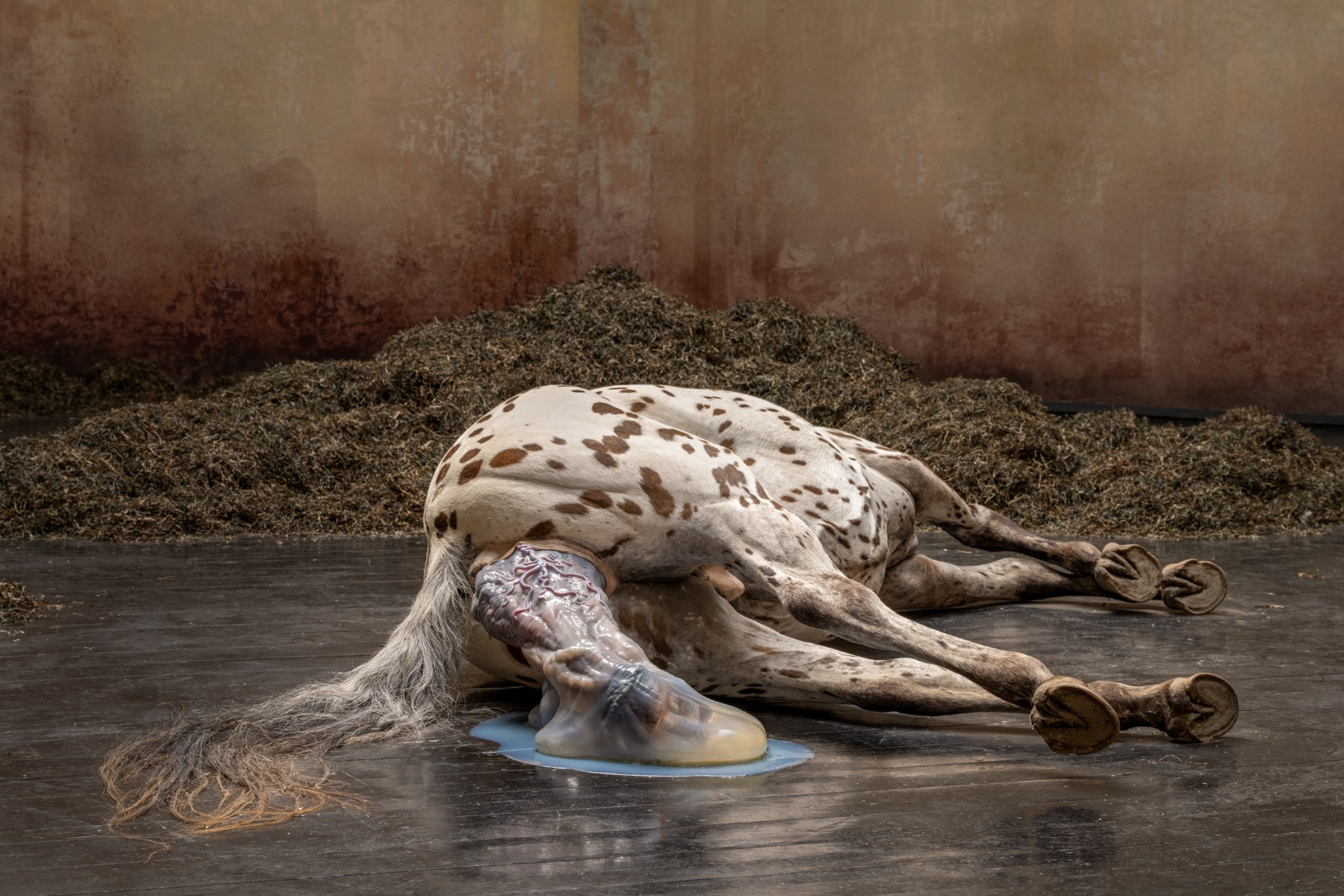
Like a freeze-frame from a film about a small family of centaurs, the installation marks a dramatic turning point in the lives of these interspecies creatures. One of the hyper-realistic centaur figures has just given birth, while the other has died. The timeline of the narrative marks an abstract stage in the history of Danish agriculture in an era of future high-tech. The artist’s intention is to imagine what the human farmer will look like in a world dominated by artificial intelligence that is also experiencing the escalation of climate change.
Installation view. We Walked the Earth Harnessing by Uffe Isolotto at the Den Frie Centre of Contemporary Art in Copenhagen. Photo: David Stjernholm
As the title of the exhibition suggests, this scenario is presently flourishing in Riga. ‘Growth’ is a commonly used metaphor for the rise of civilisation through the taming of nature. Although this interference in natural processes can lead to civilisation becoming destructive not only in terms of the natural world but also towards itself, the centaurs seem to have found the promise of a future and continuity. That is, the release of offspring into the world symbolises the embodiment of a new beginning that could mean a return to a simple farming way of life.
Each of Isolotto’s three exhibitions has taken on a certain aspect not only of the space in which it is exhibited, but also of the cultural context of the country where it is being shown. In Latvia, the installation is accompanied by floral elements typical of Riga’s Art Nouveau architecture, while the post-apocalyptic mood is illuminated by the promise of sunlight streaming through the windows and the sense of proximity to the natural world outside the exhibition space’s walls. Likewise, the exhibition can be read in different ways not only in terms of what one actually sees but also from the accompanying text written by the curator – in Venice it was more abstract, whereas in Riga it is prosaic and full of love and hope.
Uffe Isolotto is an interdisciplinary artist who works with spatial and digital sculpture, video art, and animation. His creative trajectory is dominated by a reflection of today’s changing technological reality through composite bodies that challenge notions of the human and the non-human. His work focuses on a post-human future in which humans are increasingly alienated from the technologies of their own making and a return to nature is becoming increasingly difficult.
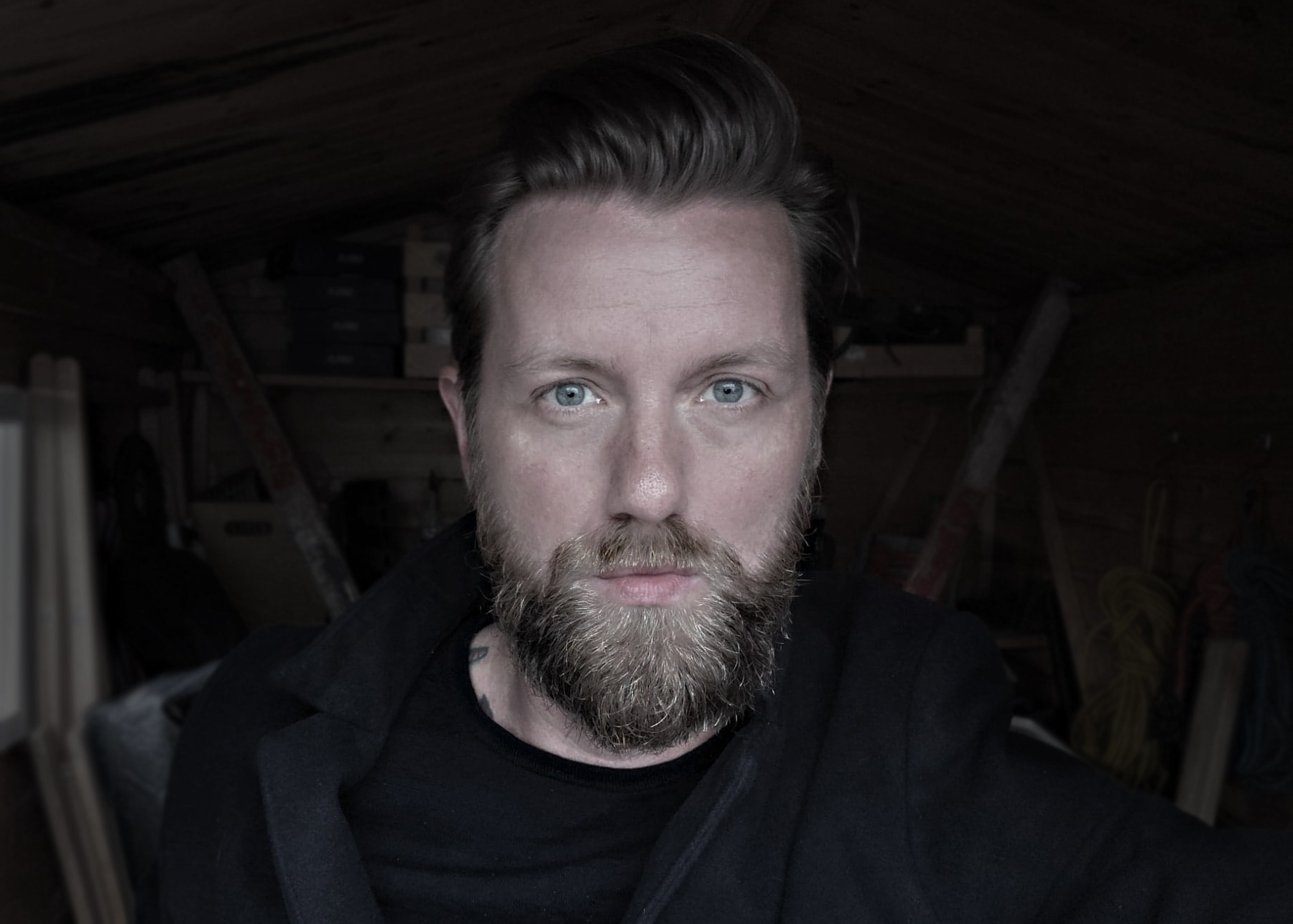
I would like to start with a brief overview of your biography and the key points that have shaped your artistic journey. Today, information technology is a persistent presence in our day-to-day life, but what initially sparked your passionate interest in technology?
I was born in 1976 and was acquainted with computers from a very young age. Maybe I didn’t witness the birth of the computer itself, but I certainly experienced the emergence of the internet and the birth of many other technologies – starting with the old green screens to today’s small laptops. I wasn’t a native when it came to computers, but I was naturally curious about this vast world that has now become so expansive.
Furthermore, it was natural for me to use computers early on to create artworks. When I applied for art school in 2001, I created drawings using Photoshop 7.0. I then printed them out in a large format on foam board, which made them resemble paintings. However, this printing process didn’t quite work for me, and after a while, I stopped using it. This decision was partly influenced by my professors, who struggled to categorise my work – they couldn’t decide whether it was wrapping paper or a painting. As a result, I shifted my focus to the creation of more graphic artworks.
Also, it has to be said that I initially wrote poetry; that was really the thing I lived for. Then I decided to transfer poetry to the visual arts. I recognised that words are essentially symbols that convey meanings, much like how a page represents a space. This realisation led me to explore the realm of ready-mades, incorporating objects from culture into my artistic process. I was using either technology to do that or the people who deal with technology – people who were good at making 3D objects, programming, and so on.
Installation view. We Walked the Earth Harnessing by Uffe Isolotto at the Den Frie Centre of Contemporary Art in Copenhagen. Photo: David Stjernholm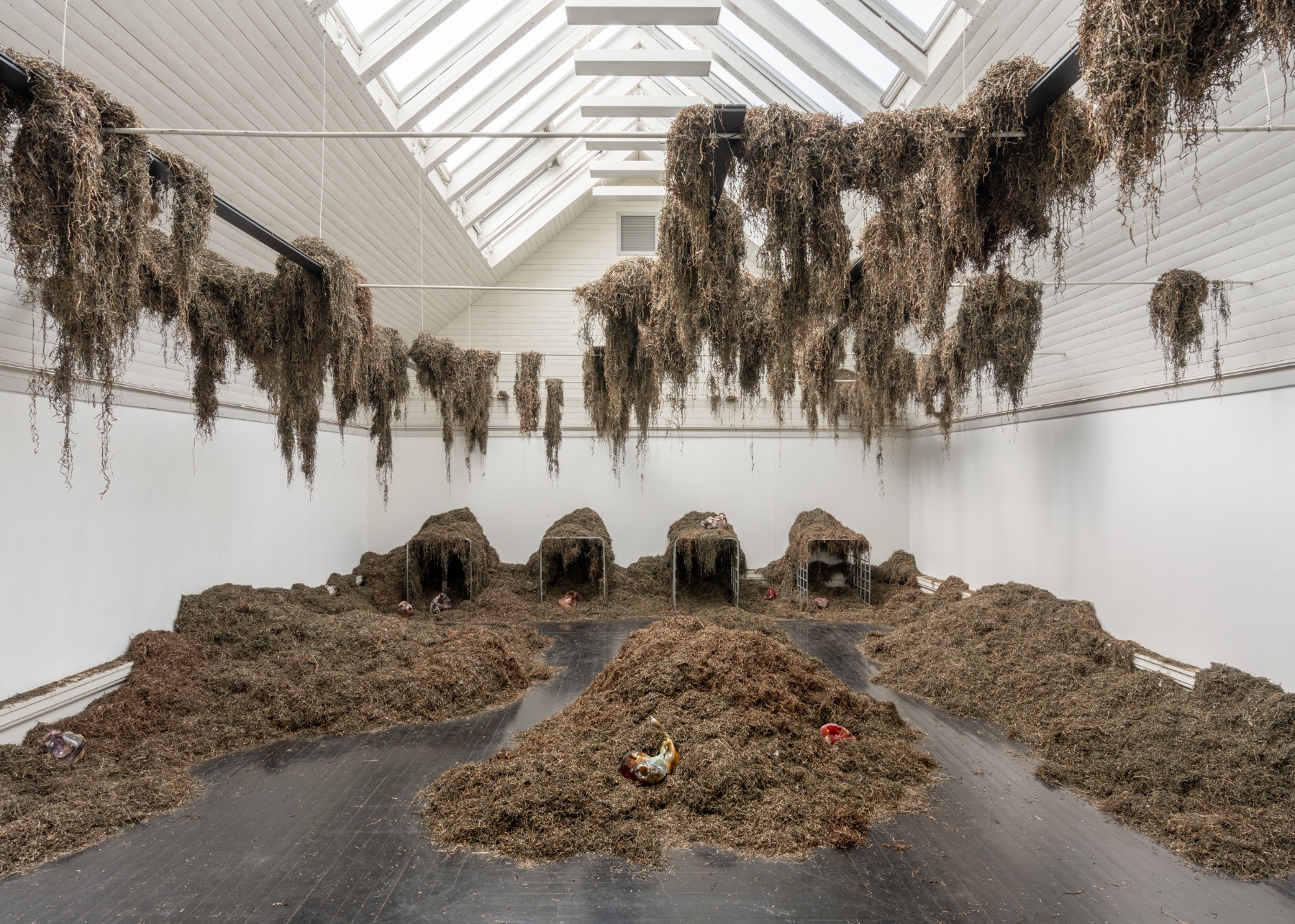
In this installation, the focus is on how we could ‘unlearn’ technological skills and our dependence on it and return to a time before agriculture. You specifically depicted this in Denmark by implying a pre-agricultural era.
For that particular exhibition, I had to delve deeply into exploring what defines Denmark. So I investigated and spent a lot of time in an open-air museum on the outskirts of Copenhagen. I immersed myself in that environment in order to grasp the nuances of its light, aroma and atmosphere, paying special attention to the colours prevalent in that setting. While I may not have incorporated them extensively into this specific project in Riga, which has a more greyish hue, in order to adapt to the concrete feel of the unfinished building, I used some of those colours in previous exhibitions. It was my way of bringing some of this specific cultural heritage into an international context, although still very context-specific. In Venice, I responded to the city’s historical architecture and perfect decay, while here, it’s a new corporate building. In this brand-new and bare setting, I still wanted to create some insecurity about what time we are in or what will happen, so there are layers of an imagined past or a presumed future in it, to counter all the newness.
Installation view. We Walked the Earth: The Growth by Uffe Isolotto at the Latvian Museum of Contemporary Art’s exhibition space New Hanza Biroji. Photo: Kristīne Madjare
The patina-covered historical columns installed in this pristine, fresh office building create a sort of confusion about the time we find ourselves in.
These columns are inspired by the abundance of Art Nouveau in Riga, which in Copenhagen is entirely non-existent. It’s a context-specific decision, and I wanted to integrate this element into the exhibition, because it’s important to create a connection between what’s ‘outside’ and what’s ‘inside’.
I find the stylised ‘growth’ very interesting. We are part of nature and we learn from nature, so it’s just natural to look towards nature, both in terms of mimicking shapes, but also when it comes to functionality. I’m curious about stuff like generative design. For example, when constructing wings for aeroplanes – instead of making a model of the physical framework, designers use a computer to calculate where the optimal supports will be and as a result thereof, where to put the material. It’s a sort of branch-like structure that looks super organic and natural but also alien.
Generative design sort of fuses into this idea of growth, like economical growth, because it’s better and it’s cheaper for aviation and so on. It becomes a new way of expressing ourselves because there’s a language we didn’t see before and it comes into creation through collaboration with computing and AI.
Installation view. We Walked the Earth: The Growth by Uffe Isolotto at the Latvian Museum of Contemporary Art’s exhibition space New Hanza Biroji. Photo: Kristīne Madjare
Seeing as the centaur is a creature from Greek mythology, where and how does the mythology aspect enter into the concept?
The idea in Venice was to have something that people would instantly recognise. Something that they’ve seen before – perhaps in art history, in fantasy genres, maybe in Harry Potter. It has sort of transferred from art history into fantasy illustrations and DeviantArt. I don’t know if you’re familiar with the website, but it’s a platform where people share visual materials they’ve created. On that site, I came across an image of a highly expressive pastel painting depicting a centaur in the throes of giving birth. The artwork was remarkably intense, filled with an anxiety far more pronounced than what we can see in my own work here. This image left a lasting impression on me… it truly stuck with me and I wanted to transfer that feeling to others through my own work.
In my work, centaurs originate from mythology, but they have transformed into something different. They serve as symbols representing the intersection of humanity and the animal world. I put my focus on these discussions centred around the idea that we are not the central focus of Earth anymore. We’re grappling with the concept of anthropocentrism and attempting to shift our perspective to view ourselves as a part of a larger whole.
How exactly did you arrive at the concept of using centaurs?
Regarding the centaurs, the curator Jacob Lillemose and I have engaged in discussions about various possibilities regarding their origins. Initially, I crafted a narrative – an origin story for the entire world and up to the present time. It was just a tool to work with – nothing to be published; it was just for myself, to understand whether there is some kind of logic there.
In this story, we work with the idea of bioengineering. When you have science, you have new discoveries, you have new possibilities – and maybe you can create a bioengineered man-animal. This could be just one product – we can only think about what other products there could be. We don’t know if these are the only two instances, or if there is an entire population of the species, or if it came into existence naturally. It raises questions about whether humanity might adapt to a changing world in the future, driven by shifting conditions, in order to survive or coexist in this evolving environment. As the conditions on Earth undergo change, the question arises: how can we ensure our survival in a changing world? Perhaps adaptation is the key, and maybe humans have played a role in bringing about this change intentionally. It’s a concept somewhat akin to the development of robot technology and artificial intelligence – we create these entities because we have the capability to do so, but the ultimate destination or consequences of these creations remain uncertain. And there’s the possibility that it’s just a new version of us because we’re always changing.
Installation view. We Walked the Earth Harnessing by Uffe Isolotto at the Den Frie Centre of Contemporary Art in Copenhagen. Photo: David Stjernholm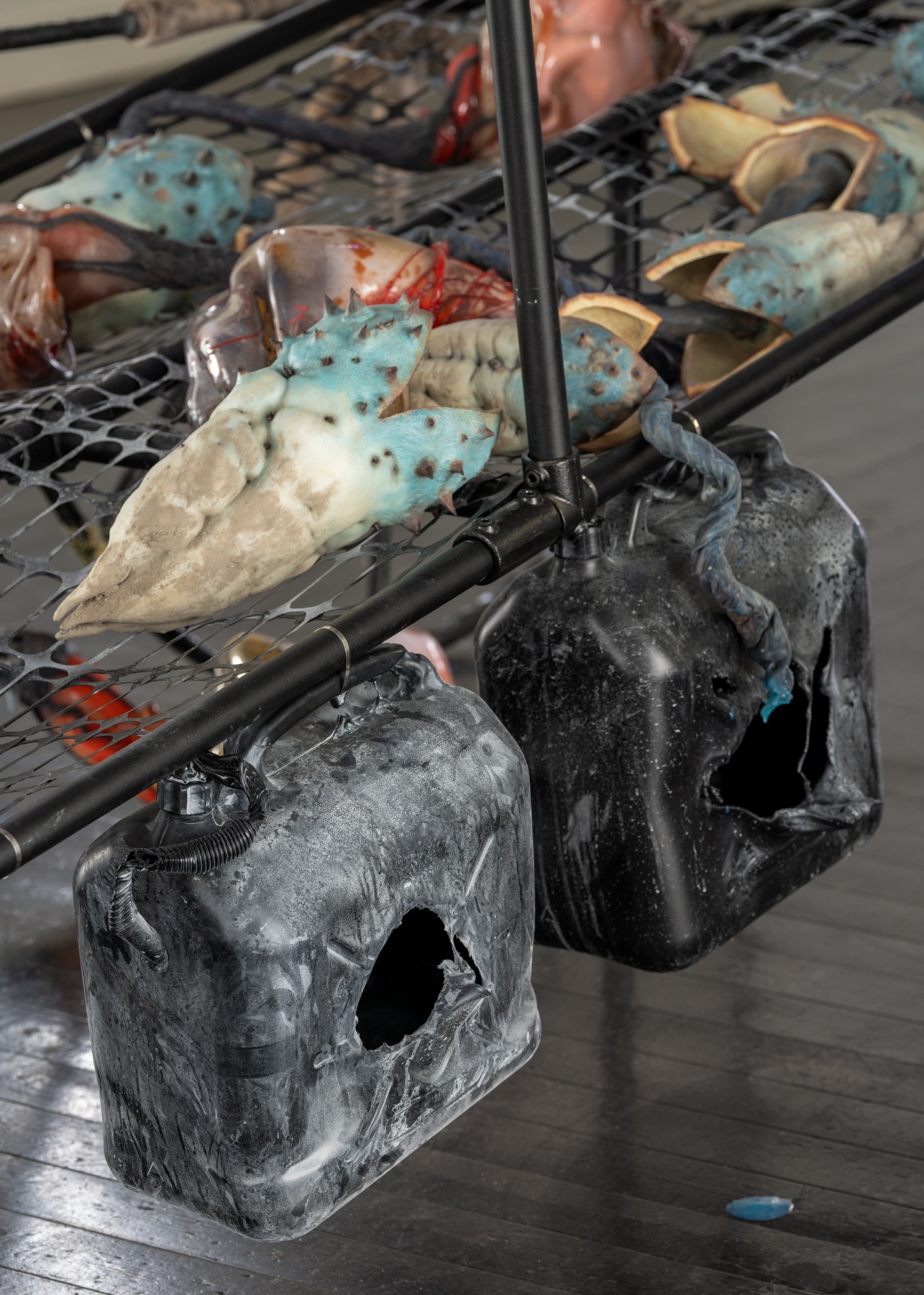
Alongside the centaurs, your created world is also inhabited by other living things. In the real world, historically, along with agriculture and farming, our chosen animals and plants gradually began to change. They no longer needed to protect themselves from predators; plants were no longer required to compete with other species for water and sunlight. Plants responded with larger seeds, fruits, and bulbs, while the ears of animals drooped down, their tails curled, etc. Could you tell us more about some altered and distorted elements of your created world in detail?
Yes, the two centaurs in the exhibition are not the only creatures here – we have other species living in this world. There is a type of crop that resembles chestnuts, as well as beetroots and turnips. An umbilical-cord sprouts forth from them and connects to something resembling the interior of an oyster, almost like intestines. I tried to make a crop that is neither in the ground nor on the seabed – something that could be both in water and in the soil. You can observe this in the exhibit where they are crafted from resin and glass, and they represent a unique fusion of various species. I made these for the Venice edition, but for the exhibition in Copenhagen, I extended these species with a kind of ‘crab’. It’s a blend of a crab and some phallic, pinkish tentacles, intertwined with elements of technology. These peculiar creatures possess legs adorned with orange inscriptions that resemble alien symbols, echoed in the orange cables on the ceiling in the installation. It’s inspired by real life because these tentacles actually exist as an animal in real life – it’s called ‘goose barnacles’. I’m inspired by what’s already there, because when you look at, for instance, deep sea creatures and other animals we rarely get to see, they seem completely alien to us.
Installation views. We Walked the Earth: The Growth by Uffe Isolotto at the Latvian Museum of Contemporary Art’s exhibition space New Hanza Biroji. Photos: Kristīne Madjare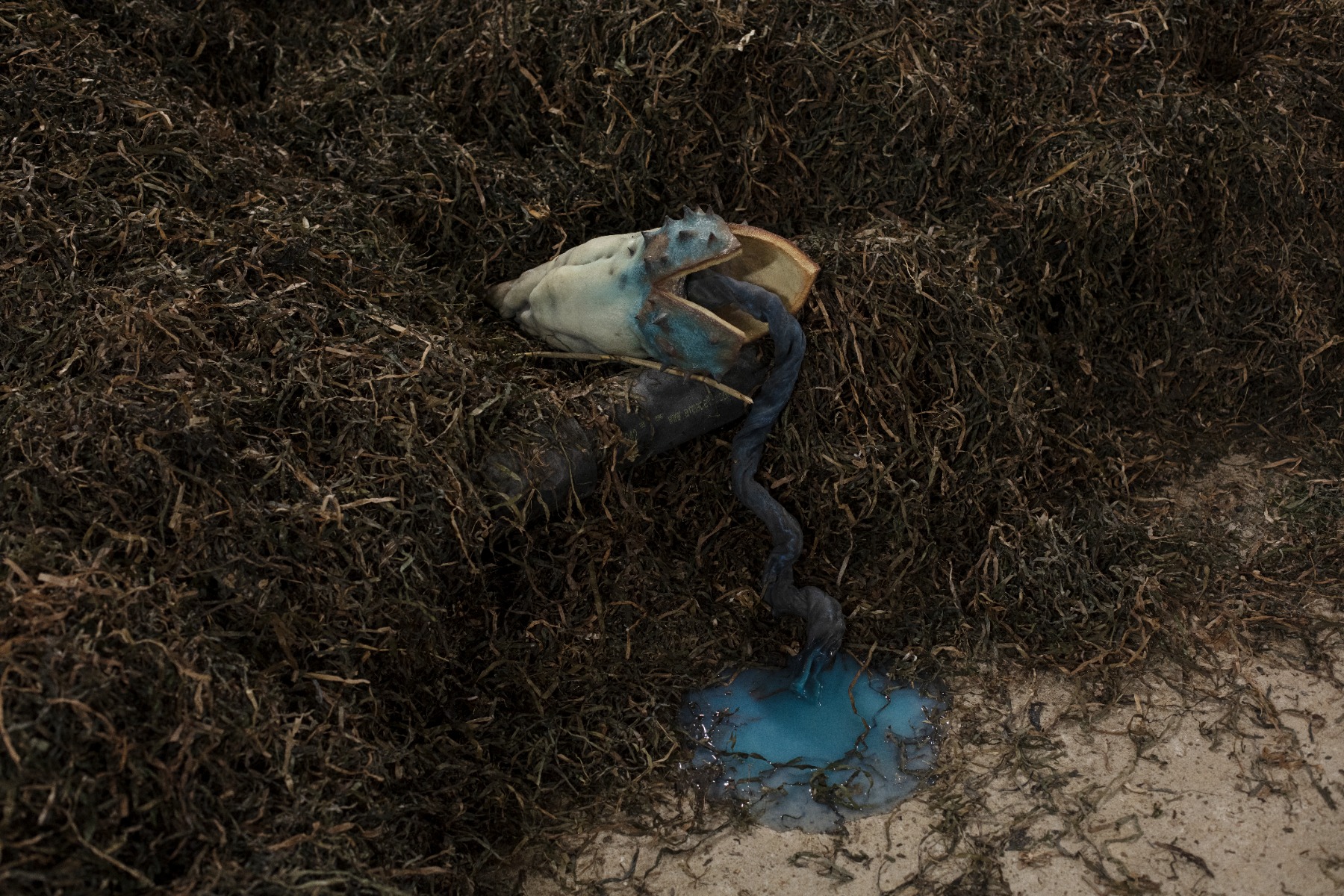

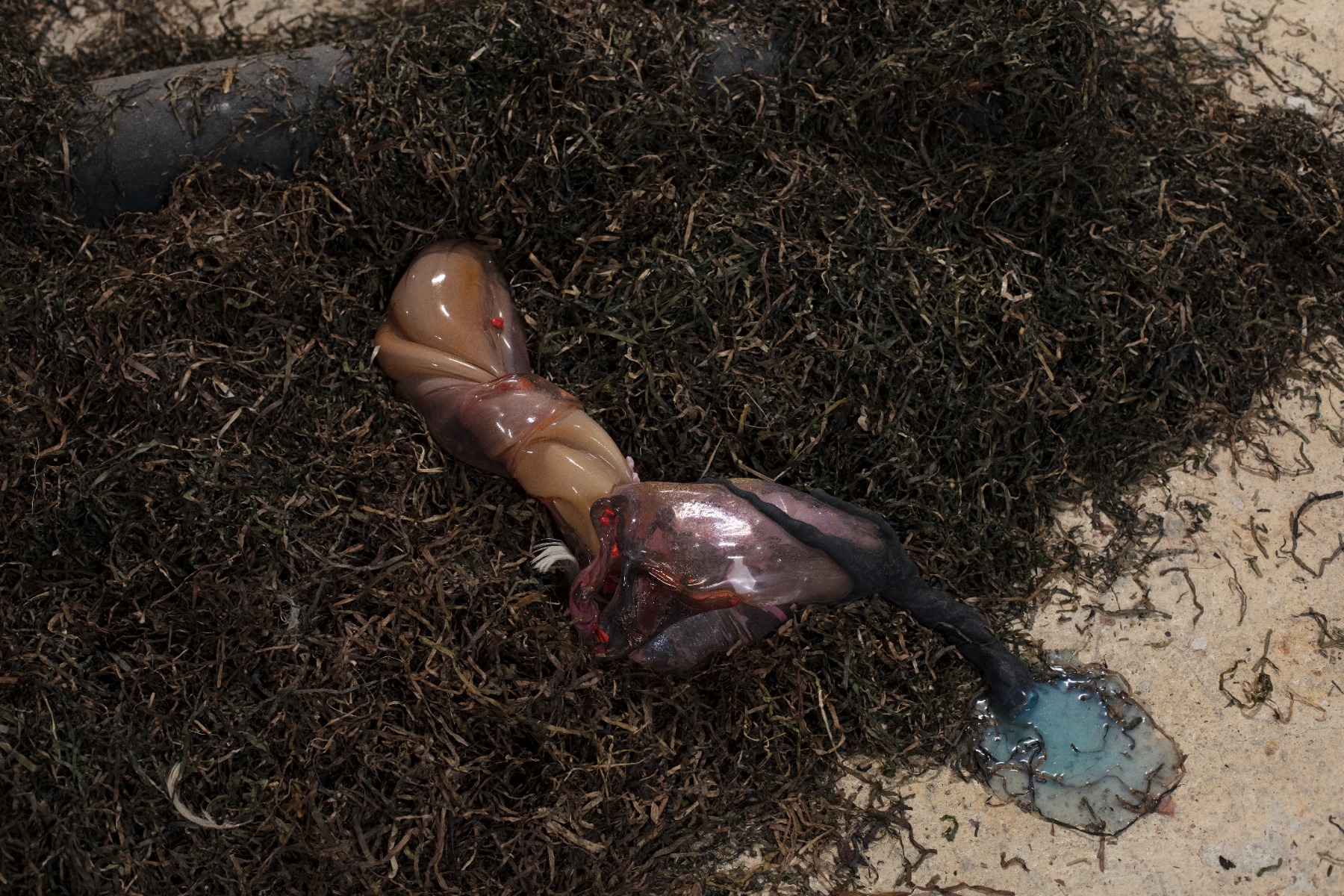
How do the specific elements/additions that you’ve incorporated into your installation here in Riga change and/or influence the overall message and emotional impact of the artwork?
Every time you place something differently in connection to each other, it changes meaning. In this show, everything is contained within a single space, whereas in previous exhibitions, you could go on a tour where the rooms were connected to one another in various ways. Here, it is like a condensed psychological drama. In theatre, there’s the chamber play where you have just one stage, one set, and maybe just two people; they are talking, and it could be tense. So I see this in that way.
But then we also play around with different positionings of these things – so people will maybe read it slightly differently. Here, in this exhibition, we have a mutated ham between the two centaurs, whereas in the other two exhibitions, it was placed to the side, in the corner of the exhibition. It’s a response to the space itself but also just opens up possibilities that we haven’t seen before, so you can get slightly different readings in slightly different scenarios. It’s like the world is changing around them, but they are always the same.
That’s why we also have different subtitles – this time it is The Growth, whereas last time it was Harnessing. Inspired by filmmaking, we kept the main title for recognition, and opened up aspects of the world in the subtitle. And film production in general has been an inspiration to us during the making of this, so it just felt natural to have it this way.
Installation view. We Walked the Earth: The Growth by Uffe Isolotto at the Latvian Museum of Contemporary Art’s exhibition space New Hanza Biroji. Photo: Kristīne Madjare
And what does this imagined world look like after The Growth?
After the growth? Well, if you think about civilisations, you always have a decline or some kind of collapse of them. Growth is natural, but if you force growth, you get something that becomes very unnatural. In a sense, if you want cows to produce more meat, you can grow cows that are full of muscles, but then their legs will break from the added weight.
I’m also intrigued by the notion of growth as a societal principle, especially financial growth, which hasn’t necessarily proven to be a universally beneficial concept. Over time, we become accustomed to the benefits that growth brings us. However, the challenge lies in unlearning these patterns and finding ways to distance ourselves from them. Consider all the conveniences we’ve become accustomed to, such as smart technologies. They’ve become an integral part of our lives, almost an extension of ourselves.
Installation view. We Walked the Earth: The Growth by Uffe Isolotto at the Latvian Museum of Contemporary Art’s exhibition space New Hanza Biroji. Photo: Kristīne Madjare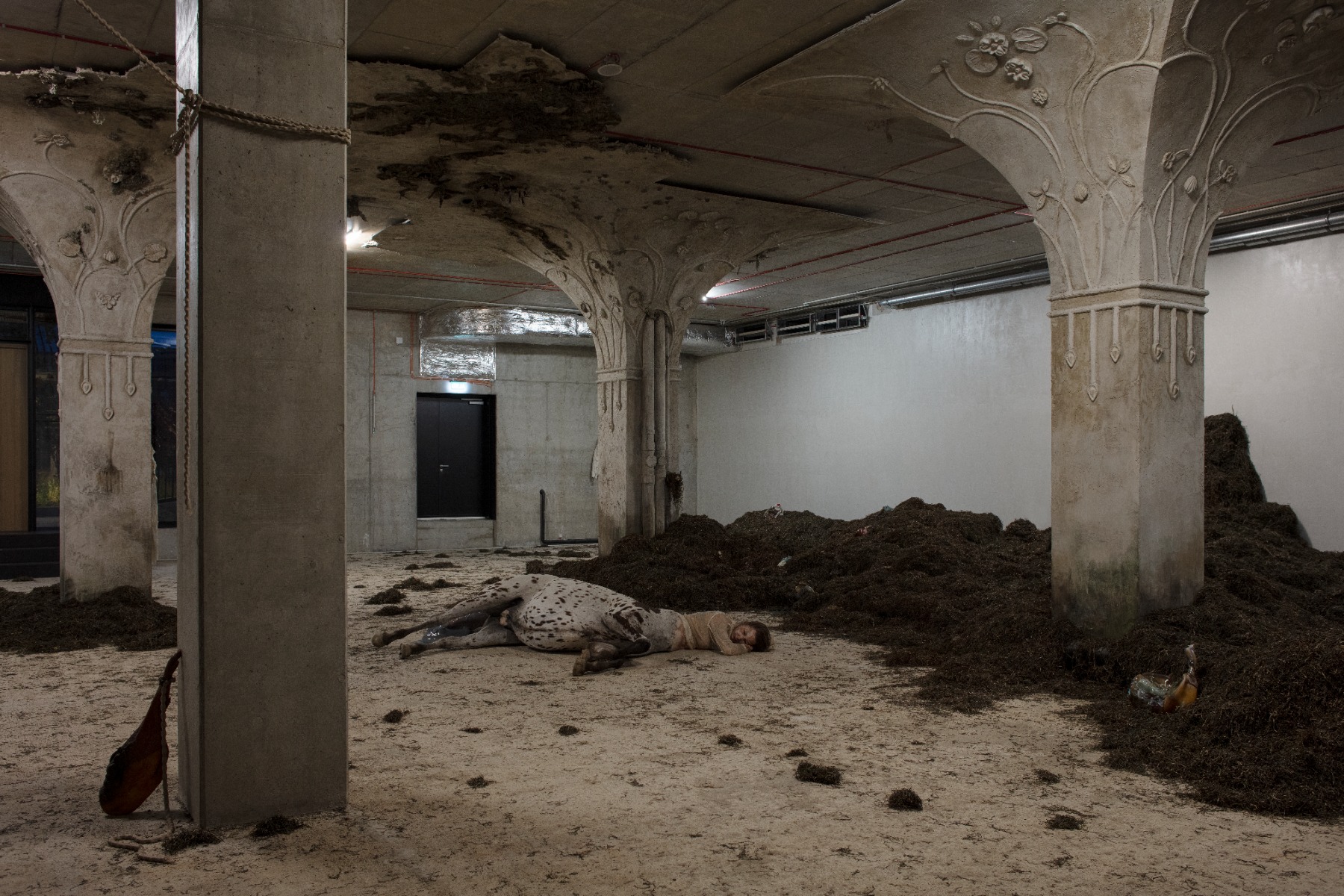
You said that the creation of this work feels like a film production in a way. Do you perceive yourself as a sort of director?
Sure, I work with people who work in the film industry, and my role is more like that of director. I collaborate with a diverse team that includes fashion designers, special effects makeup artists, glass artists, designers, graphic artists, model makers, and various other creative professionals. In this collaborative effort, I take on the role of having the overall vision and bearing the responsibility for the project. This dynamic is more akin to film production than traditional art production, and it’s from this realm that I draw my influences.
I’m particularly intrigued by concept art sketches, the preliminary drawings made before creating the actual product for film and video games. These sketches represent a stage of the creative process where there’s immense potential and the possibilities are vast. As ideas are refined and narrowed down, they eventually lead to the final product. However, I find this early stage, where the creative direction can take any path, incredibly fascinating because it feels like a whole world is taking shape, not just a specific narrative.
You use world-building as a method to create narratives within your art. Considering that contemporary art often deals with complex issues, how do you see world-building as a means to address contemporary social or environmental challenges?
It is something that’s not used so much in contemporary art but more in literature, film, and video games, where you build the world first and then you play out the narrative you create – geography, demography, monetary system, religious beliefs, sexuality, everything.
But I see it has a place and it’s becoming more common because people watch movies and play video games and immerse themselves. The audience wants more immersive art experiences; they want to be part of it. Which I find to be very uplifting, because it means that you engage with the world around you. You could write it off as just entertainment, but I prefer to believe that having strong individual experiences with art will do a lot for you and for society. It’s old-fashioned storytelling in a new wrapping, and we need to tell these stories and share them with each other.
Installation view. We Walked the Earth: The Growth by Uffe Isolotto at the Latvian Museum of Contemporary Art’s exhibition space New Hanza Biroji. Photo: Kristīne Madjare
As an artist specialising in hyperrealistic installations, how do you see the future of this art form evolving?
It’s a funny thing because there are quite a few artists working with this – we all know them, like Duane Hanson and Patricia Piccinini. And it’s something that’s both frowned upon and a success because we want to mirror ourselves in whatever we see. It’s just… It’s very primal in that sense. We cannot escape our bodies, we cannot escape that we are humans and curious about ourselves. So when we see something, we project ourselves onto it. It could be a conceptual idea just in writing, it could be anything, but this mirroring effect that the hyperreal has, it instantly goes to your guts before it goes to your head, because you relate to it with your body. I think that was interesting to work with. It’s not the first time I’ve made hyper-realistic sculptures, but it’s the first time on this scale and with this level of credibility.
Installation view. We Walked the Earth: The Growth by Uffe Isolotto at the Latvian Museum of Contemporary Art’s exhibition space New Hanza Biroji. Photo: Kristīne Madjare
Together with your wife, the artist and curator Nanna Starck, you run the exhibition and production platform Age of Aquarius, which has cultivated various ecologies, both biological and synthetic. Could you elaborate on this project?
Well, it has been hibernating for some time now. It’s an exhibition platform that takes place where we live – so, it’s also in a private space. We live on the top storey of a building and we have a rooftop garden there which is really beautiful, and you can see all of Copenhagen from there, which is at the same height, so it’s like a landscape of rooftops and spires. We wanted to share this space because it had a feeling of public and private at the same time, formal and intimate, which we found to be a good base for the activities.
We engaged with various types of ecologies, including biological, synthetic, and digital ecosystems. We invited individuals to showcase their work outdoors, through curated exhibitions. Our projects encompassed sculptures, performances, and pieces that integrate technology. We aimed to explore this intersection at a time when there were relatively few spaces addressing ecological themes, but time caught up with it and now this is more the standard. We also collaborated with Jacob Lillemose. At the time, he was running an exhibition space called X and Beyond, which was his postdoc space. We operated as an artist duo and held exhibitions in Italy, Leipzig and various other locations, but we also took on the role of curators. Therefore, our approach was not strictly one or the other; rather, we were highly versatile and adaptable in our creative endeavors.
Installation views. We Walked the Earth: The Growth by Uffe Isolotto at the Latvian Museum of Contemporary Art’s exhibition space New Hanza Biroji. Photos: Kristīne Madjare

Age of Aquarius was actually the starting point from which your practice gradually merged into one that encompasses the body, technology, and ecologies in the broadest sense.
Yes, what I took from this is this ecological interest… this holistic thinking.
The term ‘Age of Aquarius’ originates from the 1960s and is closely associated with the musical Hair from that period. It references not only a particular astrological age but also captures the visionary thinking associated with Aquarius. Importantly, this concept isn’t confined to the 1960s; astrological ages, including the Age of Aquarius, span roughly a couple of thousand years.
My interest is not so much the astrology part, but that we are at a time where it feels like there’s a break. Something’s happening. It has been happening for a while, of course. The advent of agriculture and how that’s shaped Earth. But now we’re going places that we don’t know in many different ways, so it feels unsettling. For some people it’s promising, like we can live on Mars, but for others – it’s true horror, and they just want to go to the countryside and have a small cottage. But it’s essentially the same concept. Whether you’re in a countryside cottage with a small ecological system, harvesting your own food, or on Mars living in small tribes, the fundamental idea remains unchanged. In both scenarios, you’re part of united communities, though the difference lies in the ability to easily travel, as you can’t hop on an airplane and go to Mars. This longing for tribes and small communities may stem from a feeling that the world has become somewhat too vast.
And we are under constant stress by all this news about what’s happening on our side of the earth, which is relevant because it affects us. We are in a global age, but maybe we’re not there – our minds are not there yet. Like, our bodies and our sight haven’t adjusted to driving cars – we actually cannot go that fast. We are still the same kind of humans as we were 500 years ago, and we are adapting – but not that fast. Technology is evolving faster than we can adapt. But, of course, we can’t avoid the use of technology because it has been integral to human existence since early times, much like a stick or a rock. We cannot separate ourselves from technology, so denouncing technology doesn’t make sense. Maybe its speed and the amount are the issues.
We’ve become increasingly dependent on technology, to the point where it’s difficult to function in society without a smartphone – even basic tasks, like taking a bus, can be challenging without one. Life can become quite troublesome if you attempt to do so. Therefore, we must embrace technology to a certain extent, but it’s equally important to reflect on its implications and we have to self-regulate.
***
Uffe Isolotto lives and works in Copenhagen, which is where he graduated from the Royal Danish Academy of Art in 2007. He is an active exhibitor both in Denmark and abroad, including the ARKEN Museum of Modern Art, Den Frie Centre for Contemporary Art, the Nicolai Centre for Contemporary Art, Malmö Art Space, and elsewhere. His work is included in the collections of the National Gallery of Denmark and the Holstebro Art Museum. In 2022 he represented Denmark at the Venice Biennale.